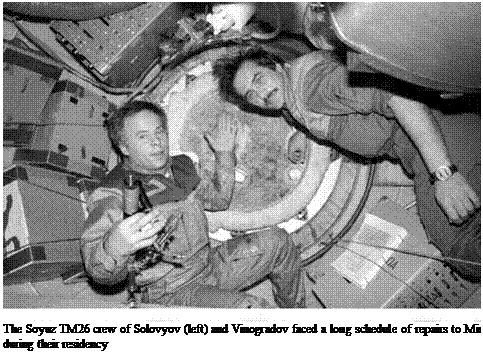. SOYUZ TM26
Flight Crew
SOLOVYOV, Anatoli Yakovlevich, 49, Russian Air Force, commander,
5th mission
Previous missions: Soyuz TM5 (1988); Soyuz TM9 (1990); Soyuz TM15 (1992); EO-19 (1995)
VINOGRADOV, Pavel Vladimirovich, 43, civilian, flight engineer
Flight Log
The EO-24 cosmonauts arrived at Mir on 7 August to take over from the tired EO-23 crew. This time, there was an abbreviated hand-over period to avoid putting too much strain on the station’s systems or departing EO-23 crew. The day after the TM25 spacecraft left Mir, Solovyov, Vinogradov and Foale relocated the TM26 spacecraft from the aft to the front port of Mir, taking close-up pictures of the damaged Spektr module on the way.
Most of the new resident crew’s work would concentrate on restoring Mir to operational status again, but they also had to cope with two changes of American crew members. In late September, STS-86 docked with Mir, bringing much-needed supplies and astronaut Dave Wolf to take over from Mike Foale. In January 1998, STS-89 arrived with Andy Thomas aboard, the seventh and final NASA astronaut to work aboard the Mir complex with a resident crew. A couple of days after Wolf returned home, the replacement Mir EO-25 resident crew arrived aboard Soyuz TM27 to continue Mir residency with Thomas. Also aboard TM27 was French cosmonaut researcher Leopold Eyharts, who would return to Earth with Solovyov and Vinogradov in TM26 after completing his research programme.
The seven EVAs conducted by the EO-24 crew made up one of the most extensive spacewalk schedules of the whole Mir programme. Solovyov was outside for all seven of the EVAs, with three different colleagues (one Russian and two American). The first EVA (22 Aug, 3 hours 16 minutes) saw the two cosmonauts re-enter the Spektr

module (while Foale remained in the Soyuz). Upon entering the dark, cold module, the cosmonauts found white crystals floating around and surfaces covered in a layer of frost. The crew reconnected power cables to a new, modified hatch plate to allow the use of the undamaged solar arrays on the Spektr module. They also retrieved several items for Foale from the module before it was permanently sealed. Partial electrical power was restored, but the system would not allow the solar arrays to track the Sun, preventing maximum power output. On the next EVA (6 Sep, 6 hours 0 minutes), Solovyov and Foale conducted an external inspection of Spektr, videoing the exterior for analysis on the ground. The next three EVAs (20 Oct, 6 hours 38 minutes; 3 Nov, 6 hours 4 minutes; and 6 Nov, 6 hours 17 minutes) were completed by the two Russians and included reconnection of cables in an IVA, and relocation of solar arrays from the Kvant module. On the second of these three EVAs, the outer hatch of Kvant 2 failed to hermetically seal. The “C” clamp used since 1990 had finally deteriorated and required replacement. This was initially planned for this crew, but was subsequently postponed for the following resident crew instead. The sixth EVA (9 Jan 1998, 4 hours 4 minutes) saw the two Russians complete a photodocumentation of the Mir exterior, including the Kvant 2 hatch area, as well as retrieving several exterior experiments. The last EVA of the expedition (14 Jan, 6 hours 38 minutes) was completed by Solovyov and Wolf and included the use of a spectro – reflectometer to examine the physical condition of the station’s exterior surfaces.
Having launched in the warm August temperatures, the EO-24 crew came home to snow. A helicopter remained close by the grounded Soyuz with its rotors spinning
to prevent ice from building up before the crew could be extracted. The three cosmonauts (including Eyharts) were immediately carried away on stretchers and airlifted away from the harsh conditions of the landing zone.
Milestones
200th manned space flight 85th Russian manned space flight 78th manned Soyuz mission 25th manned Soyuz TM mission 24th Mir resident crew
31st Russian and 66th flight with EVA operations










